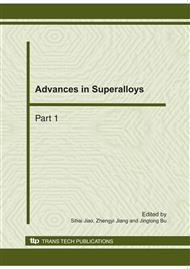p.1440
p.1446
p.1451
p.1458
p.1463
p.1469
p.1473
p.1477
p.1482
Fractional Exponent of the Modified Stokes-Einstein Relation in the Metallic Glass-Forming Melt Pd43Cu27Ni10P20
Abstract:
The diffusion coefficient in the metallic glass-forming systems such as Pd-Cu-Ni-P exhibits a marked deviation from the Stokes-Einstein (SE) relation in the proximity of the glass transition temperature. Such a deviation is characterized by the fractional exponent p of the modified SE expression. For the material Pd43Cu27Ni10P20, it has been reported that it takes the value p = 0.75. In this work, it is shown that the value of p is highly correlated with the ratio ED / ENB, where ED and ENB are the activation energies for diffusion coefficient D and cooperativity NB defined by the Bond Strength-Coordination Number Fluctuation (BSCNF) model. The present paper reports that for the metallic glass-forming melt Pd43Cu27Ni10P20, the fractional exponent p can be calculated accurately within the framework of the BSCNF model.
Info:
Periodical:
Pages:
1463-1468
Citation:
Online since:
October 2010
Authors:
Price:
Сopyright:
© 2011 Trans Tech Publications Ltd. All Rights Reserved
Share:
Citation:


